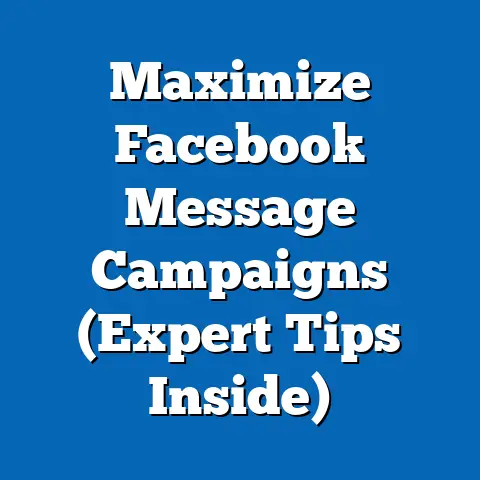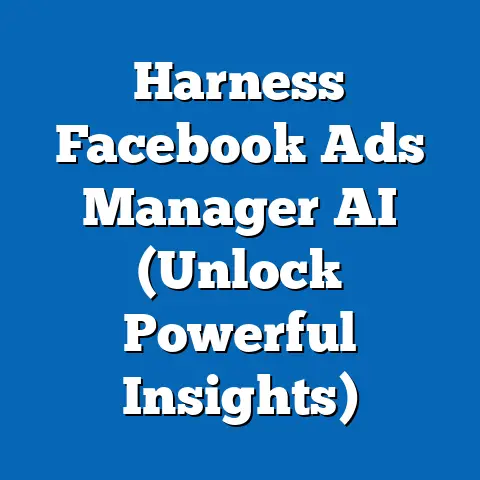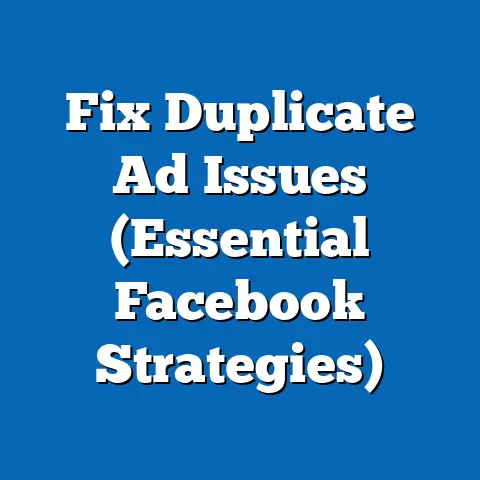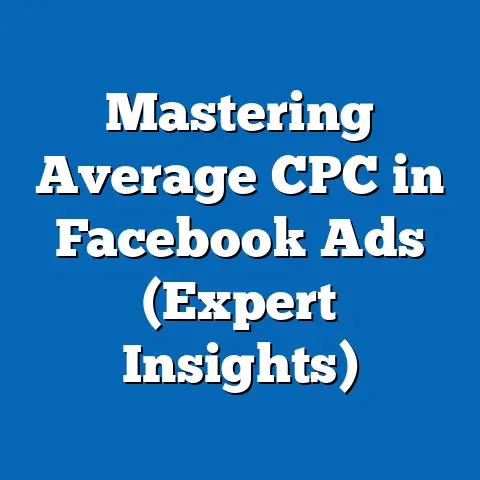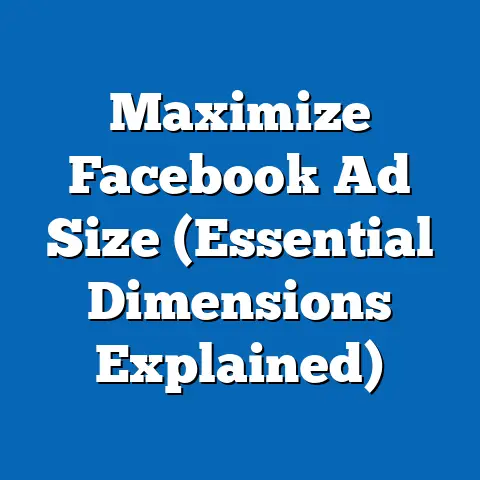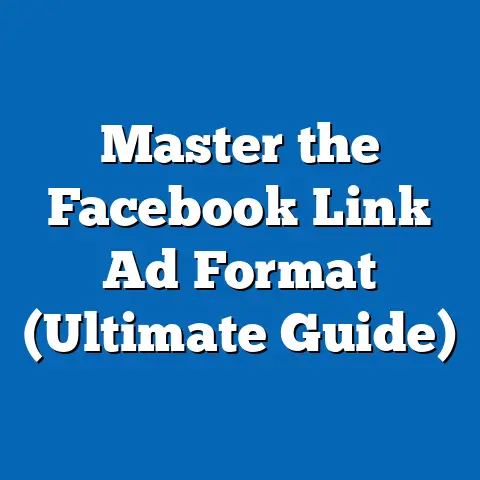Pause Facebook Ads Effectively (Expert Timing Strategies)
Have you ever noticed how some businesses seem to effortlessly glide through Facebook advertising, consistently hitting their targets and optimizing their campaigns, while others constantly struggle, burning through budgets with little to show for it? I’ve seen it firsthand, both as a consultant and as an advertiser myself. The secret, more often than not, isn’t just about having a great product or a catchy ad creative – it’s about understanding the rhythm of your campaigns and knowing precisely when to pause those ads for maximum impact.
Here’s what we’ll cover:
- Understanding the Importance of Timing: Why timing matters more than you think and how it impacts your key performance indicators (KPIs).
- Signs It’s Time to Pause: The telltale signs that your ads are losing steam and it’s time to hit the pause button.
- Expert Strategies for Timing Your Pauses: Proven techniques for determining the optimal time to pause your ads, including testing, seasonal trends, and audience insights.
- Techniques for Effective Pausing: How to pause your ads without losing momentum and leverage automated rules.
- Analyzing the Aftermath: How to analyze the impact of pausing your ads and use those insights to improve future campaigns.
- Retargeting and Re-Engagement: How to effectively reintegrate paused ads back into your campaign and re-engage your audience with fresh content.
Get ready to take your Facebook advertising game to the next level. Let’s dive in!
Section 1: Understanding the Importance of Timing in Facebook Advertising
Timing in Facebook advertising isn’t just a nice-to-have; it’s a fundamental pillar of success. I’ve seen campaigns with amazing creatives completely tank because they were run at the wrong time, or for too long without a break. Think of it like this: you wouldn’t wear a winter coat in the middle of summer, would you? The same principle applies to your ads.
Defining Timing in Advertising
Timing, in the context of Facebook ads, refers to the strategic decisions surrounding when to run, pause, and resume your ad campaigns. It encompasses understanding:
- When your target audience is most active and receptive to your message.
- The optimal duration for running an ad before it becomes stale or experiences ad fatigue.
- The impact of external factors like seasonal trends, holidays, and current events on your ad performance.
It’s about much more than just choosing a start and end date. It requires a deep understanding of your audience and the ever-changing landscape of the Facebook advertising ecosystem.
The Impact on Key Metrics
The timing of your ad campaigns has a direct impact on your key performance indicators (KPIs). Let’s break down how:
- Click-Through Rate (CTR): Run your ads when your audience is most active, and you’ll see a higher CTR. This indicates that your message is resonating with them at the right time. Conversely, if your ads are running when your audience is less engaged, your CTR will plummet.
- Cost Per Click (CPC): Timing affects competition. If you’re bidding during peak hours when everyone else is also advertising, your CPC will likely increase. Strategically pausing during these periods and resuming during off-peak hours can help lower your costs.
- Conversion Rate: Even if you get clicks, you need conversions. If your audience isn’t in the right mindset to make a purchase or take the desired action when they see your ad, your conversion rate will suffer. Timing your ads to coincide with their buying habits and needs is crucial.
- Return on Investment (ROI): Ultimately, the success of your Facebook advertising efforts boils down to ROI. By optimizing your timing, you can improve your CTR, lower your CPC, and increase your conversion rate, all of which contribute to a higher ROI.
I once worked with a client who was struggling to generate leads for their online course. Their ads were well-designed, their targeting was on point, but their ROI was abysmal. After digging into the data, I discovered that they were running their ads 24/7, regardless of the day or time. We decided to experiment with pausing the ads during late-night hours and weekends, focusing our budget on weekdays during business hours. The result? Their lead generation costs were cut in half, and their ROI skyrocketed. This highlights the power of strategic timing.
The Correlation Between Ad Fatigue and Strategic Pauses
Ad fatigue is the bane of every Facebook advertiser’s existence. It happens when your audience becomes overexposed to your ads, leading to a decline in engagement, an increase in costs, and ultimately, a negative impact on your ROI.
Think about it: how many times have you seen the same ad pop up in your Facebook feed and started to tune it out? That’s ad fatigue in action.
Strategic pauses are the antidote to ad fatigue. By proactively pausing your ads before they become stale, you can:
- Prevent audience burnout: Give your audience a break from your ads and allow them to “forget” about them.
- Maintain ad relevance: Fresh ads are more likely to capture attention and generate engagement.
- Optimize your budget: Avoid wasting money on ads that are no longer performing well.
I’ve found that regularly refreshing your ad creatives and copy, combined with strategic pauses, is the most effective way to combat ad fatigue and keep your campaigns performing at their best.
Key Takeaway: Timing is a critical element of Facebook advertising success. By understanding its impact on key metrics and proactively addressing ad fatigue with strategic pauses, you can significantly improve your ROI.
Next Steps: Start analyzing your existing campaign data to identify patterns in your ad performance. When are your ads performing best? When are they performing worst? This will provide valuable insights that you can use to inform your timing strategies.
Section 2: Signs It’s Time to Pause Your Facebook Ads
Knowing when to pause your ads is just as important as knowing why you should pause them. Ignoring the warning signs can lead to wasted ad spend and a decline in your overall campaign performance. I’ve learned to be hyper-aware of these indicators and react swiftly to protect my clients’ investments.
Key Indicators That Suggest a Pause
Several key indicators can signal that it’s time to pause your Facebook ads. Keep a close eye on these metrics in your Ads Manager:
-
Declining Engagement Rates: This is often the first sign of ad fatigue. Watch for a decrease in likes, comments, shares, and click-through rates. If people are no longer interacting with your ads, it’s a clear indication that they’re becoming blind to them.
-
Rising Costs: As your audience becomes less receptive to your ads, your costs will inevitably increase. Pay attention to your Cost Per Click (CPC), Cost Per Thousand Impressions (CPM), and Cost Per Acquisition (CPA). If these metrics are trending upwards, it’s a sign that your ads are losing efficiency.
-
Negative Feedback: Facebook provides valuable data on how people are reacting to your ads. Keep an eye on negative feedback metrics like “hides,” “reports,” and “unlikes.” A spike in negative feedback indicates that your ads are annoying or irrelevant to your audience.
-
Decreasing Relevance Score: Facebook’s Relevance Score is a measure of how well your ads resonate with your target audience. A low Relevance Score (below 5) suggests that your ads are not relevant or engaging. This is a strong signal that it’s time to pause and re-evaluate your ad creative and targeting.
-
Low Frequency: Frequency is the average number of times a person sees your ad. While a high frequency can lead to ad fatigue, a low frequency can also be a problem. If your frequency is consistently below 2, it might indicate that your audience is too small or your targeting is too narrow. In this case, pausing and expanding your audience or adjusting your targeting parameters might be necessary.
-
Stagnant Results: Sometimes, even if your metrics aren’t drastically declining, your results might simply plateau. If you’re no longer seeing the same level of leads, sales, or conversions as you were before, it’s a sign that your ads have reached their peak performance and it’s time to pause and try something new.
Declining Engagement Rates: This is often the first sign of ad fatigue. Watch for a decrease in likes, comments, shares, and click-through rates. If people are no longer interacting with your ads, it’s a clear indication that they’re becoming blind to them.
Rising Costs: As your audience becomes less receptive to your ads, your costs will inevitably increase. Pay attention to your Cost Per Click (CPC), Cost Per Thousand Impressions (CPM), and Cost Per Acquisition (CPA). If these metrics are trending upwards, it’s a sign that your ads are losing efficiency.
Negative Feedback: Facebook provides valuable data on how people are reacting to your ads. Keep an eye on negative feedback metrics like “hides,” “reports,” and “unlikes.” A spike in negative feedback indicates that your ads are annoying or irrelevant to your audience.
Decreasing Relevance Score: Facebook’s Relevance Score is a measure of how well your ads resonate with your target audience. A low Relevance Score (below 5) suggests that your ads are not relevant or engaging. This is a strong signal that it’s time to pause and re-evaluate your ad creative and targeting.
Low Frequency: Frequency is the average number of times a person sees your ad. While a high frequency can lead to ad fatigue, a low frequency can also be a problem. If your frequency is consistently below 2, it might indicate that your audience is too small or your targeting is too narrow. In this case, pausing and expanding your audience or adjusting your targeting parameters might be necessary.
Stagnant Results: Sometimes, even if your metrics aren’t drastically declining, your results might simply plateau. If you’re no longer seeing the same level of leads, sales, or conversions as you were before, it’s a sign that your ads have reached their peak performance and it’s time to pause and try something new.
Identifying Ad Fatigue Through Performance Data
Ad fatigue is a gradual process, so it’s crucial to monitor your performance data regularly to identify it early on. Here’s how I approach it:
- Track key metrics over time: Create a spreadsheet or use a dashboard to track your CTR, CPC, CPA, Relevance Score, and other relevant metrics on a daily or weekly basis. This will allow you to identify trends and spot any potential issues before they escalate.
- Set benchmarks: Establish baseline performance metrics for each of your campaigns. This will provide a point of reference for identifying when your ads are underperforming.
- Use Facebook’s reporting tools: Facebook Ads Manager offers a variety of reporting tools that can help you analyze your ad performance and identify areas for improvement. Take advantage of these tools to gain a deeper understanding of how your ads are performing.
I remember a campaign I ran for an e-commerce client that was initially performing exceptionally well. Our CTR was high, our CPC was low, and we were generating a steady stream of sales. However, after a few weeks, I started to notice a gradual decline in our CTR and an increase in our CPC. I initially dismissed it as a normal fluctuation, but after a few more days, the trend became undeniable. We were experiencing ad fatigue. I immediately paused the ads, refreshed our ad creatives, and adjusted our targeting. The result? Our performance bounced back, and we were able to continue generating sales at a profitable rate.
Real-World Scenarios Where Pausing Improved Performance
Here are a few real-world scenarios where pausing ads led to improved performance:
- Scenario 1: Seasonal Product: An online retailer selling winter apparel paused their ads during the spring and summer months when demand for their products was low. When they resumed their ads in the fall, they saw a significant increase in their conversion rate and ROI.
- Scenario 2: Limited-Time Offer: A restaurant ran a Facebook ad campaign promoting a limited-time menu item. Once the promotion ended, they paused the ads to avoid confusing customers and potentially damaging their brand reputation.
- Scenario 3: Audience Saturation: A local business running ads targeting a small, geographically defined audience noticed that their frequency was extremely high. They paused their ads to give their audience a break and avoid annoying them. When they resumed their ads, they saw a significant increase in engagement.
- Scenario 4: A/B Testing: A software company was running two different versions of their Facebook ads. One version was performing significantly better than the other. They paused the underperforming ad to focus their budget on the winning ad.
Key Takeaway: Recognizing the signs that it’s time to pause your Facebook ads is crucial for maximizing your ROI and preventing ad fatigue. Monitor your key metrics regularly, track trends over time, and be prepared to react quickly when you see warning signs.
Next Steps: Implement a system for tracking your Facebook ad performance data. Set benchmarks for your key metrics and monitor them regularly. This will allow you to identify potential issues early on and take proactive steps to address them.
Section 3: Expert Strategies for Timing Your Pauses
Now that you know why and when to pause your ads, let’s dive into the how. This is where the real strategy comes into play. I’ve developed a few key strategies over the years that have helped me consistently optimize my Facebook ad campaigns.
The Power of Testing: A/B Testing for Timing Decisions
A/B testing, also known as split testing, is a powerful technique for determining the optimal time to pause and resume your ads. It involves running two or more versions of your ads simultaneously, each with a different timing strategy.
Here’s how it works:
- Create two or more ad sets: Each ad set should target the same audience and use the same ad creative, but with different timing parameters.
- Set different schedules: For example, one ad set could run continuously for 24 hours a day, 7 days a week. Another ad set could be scheduled to run only during peak hours (e.g., weekdays from 9 AM to 5 PM). A third ad set could be scheduled to run only during off-peak hours (e.g., nights and weekends).
- Monitor performance: Track the performance of each ad set closely, paying attention to metrics like CTR, CPC, CPA, and conversion rate.
- Analyze results: After a sufficient period (e.g., one week), analyze the data to determine which timing strategy is performing best.
- Adjust your campaigns: Based on your findings, adjust your campaign schedules to focus on the optimal timing strategy.
I often use A/B testing to determine the best days of the week and times of day to run my ads. For example, I might test running ads only on weekdays versus running them 24/7. Or, I might test running ads only during peak hours versus running them during off-peak hours.
The key is to be systematic and data-driven. Don’t rely on gut feelings or assumptions. Let the data guide your decisions.
Leveraging Seasonal Trends and Events
Seasonal trends and events can have a significant impact on your Facebook ad performance. Understanding these trends and adjusting your timing strategies accordingly can help you maximize your ROI.
For example:
- Holidays: During major holidays like Christmas, Thanksgiving, and Black Friday, consumer spending typically increases. Adjust your ad schedules to capitalize on this increased demand.
- Seasonal Products: If you sell seasonal products like winter apparel or summer swimwear, adjust your ad schedules to coincide with the appropriate seasons.
- Back-to-School: If you target students or parents, adjust your ad schedules to coincide with the back-to-school season.
- Local Events: If you’re a local business, adjust your ad schedules to coincide with local events like festivals, concerts, and sporting events.
I always create a marketing calendar that outlines all the major holidays and seasonal events that are relevant to my clients’ businesses. This allows me to plan my ad campaigns well in advance and adjust my timing strategies accordingly.
Furthermore, I use Google Trends to identify emerging trends and topics that are relevant to my clients’ industries. This allows me to create timely and relevant ad creatives that capture the attention of my target audience.
Utilizing Audience Insights for Precision Timing
Facebook’s Audience Insights tool provides valuable data on your target audience’s demographics, interests, behaviors, and online activity. You can use this data to determine when your audience is most active on Facebook and adjust your ad schedules accordingly.
For example, you can use Audience Insights to determine:
- When your audience is most likely to be online: This will help you determine the best times of day to run your ads.
- What devices your audience is using: This will help you optimize your ad creatives for mobile or desktop devices.
- What interests your audience has: This will help you refine your targeting parameters and create more relevant ads.
I often use Audience Insights to identify the peak hours when my target audience is most active on Facebook. I then schedule my ads to run only during those peak hours, maximizing my reach and engagement.
For example, if I’m targeting working professionals, I might schedule my ads to run during lunchtime and after work hours when they’re more likely to be browsing Facebook. Or, if I’m targeting stay-at-home parents, I might schedule my ads to run during naptime or after the kids are in bed.
Key Takeaway: Expert timing strategies involve a combination of A/B testing, leveraging seasonal trends and events, and utilizing audience insights. By systematically testing different timing strategies and adapting to changing market conditions, you can significantly improve your Facebook ad performance.
Next Steps: Start experimenting with A/B testing to determine the optimal timing strategies for your ad campaigns. Use Google Trends to identify emerging trends and topics that are relevant to your industry. And, take advantage of Facebook’s Audience Insights tool to gain a deeper understanding of your target audience’s online activity.
Section 4: Techniques for Effective Pausing
Pausing your ads isn’t just about hitting the “off” switch. It’s about doing it strategically to minimize disruption and maximize the potential for a strong comeback. I’ve learned that a thoughtful approach to pausing can actually improve your long-term campaign performance.
Pausing Without Losing Momentum
One of the biggest concerns when pausing ads is losing momentum. You don’t want to completely disappear from your audience’s radar. Here are a few techniques for pausing without losing momentum:
-
Gradual Pause: Instead of abruptly pausing all your ads, consider a gradual approach. Start by reducing your budget or pausing the worst-performing ads. This will allow you to maintain some level of visibility while minimizing wasted spend.
-
Schedule Pauses: Use Facebook’s scheduling feature to pause your ads automatically during specific times of day or days of the week. This is particularly useful if you know that your audience is less active during certain periods.
-
Run “Maintenance” Ads: While your main ads are paused, consider running a low-budget “maintenance” ad campaign. This campaign could feature a generic brand message or a simple call to action, designed to keep your brand top-of-mind without aggressively pushing a sale.
-
Adjust Your Bidding Strategy: Instead of pausing your ads entirely, you could try adjusting your bidding strategy. For example, you could lower your bid amount to reduce your costs and impressions.
-
Update Your Ad Creatives: While your ads are paused, take the opportunity to update your ad creatives and copy. This will ensure that your ads are fresh and engaging when you resume them.
Gradual Pause: Instead of abruptly pausing all your ads, consider a gradual approach. Start by reducing your budget or pausing the worst-performing ads. This will allow you to maintain some level of visibility while minimizing wasted spend.
Schedule Pauses: Use Facebook’s scheduling feature to pause your ads automatically during specific times of day or days of the week. This is particularly useful if you know that your audience is less active during certain periods.
Run “Maintenance” Ads: While your main ads are paused, consider running a low-budget “maintenance” ad campaign. This campaign could feature a generic brand message or a simple call to action, designed to keep your brand top-of-mind without aggressively pushing a sale.
Adjust Your Bidding Strategy: Instead of pausing your ads entirely, you could try adjusting your bidding strategy. For example, you could lower your bid amount to reduce your costs and impressions.
Update Your Ad Creatives: While your ads are paused, take the opportunity to update your ad creatives and copy. This will ensure that your ads are fresh and engaging when you resume them.
I once worked with a client who was hesitant to pause their ads because they were afraid of losing momentum. I suggested a gradual pause approach, where we reduced their budget by 50% and paused the worst-performing ads. We also ran a low-budget “maintenance” ad campaign featuring a generic brand message. The result? When we resumed their main ad campaign, we saw a significant increase in engagement and conversions.
Communicating Pauses to Your Audience
Transparency is key. If you’re pausing your ads for a specific reason (e.g., a limited-time offer has ended), consider communicating this to your audience. This can help build trust and prevent confusion.
Here are a few ways to communicate pauses to your audience:
- Post on your Facebook page: Let your followers know that your ads will be temporarily paused and explain why.
- Update your website: Add a message to your website explaining the temporary pause in advertising.
- Send an email to your subscribers: If you have an email list, send a message to your subscribers explaining the pause and offering a special discount or promotion when the ads resume.
I find that being upfront and honest with your audience can go a long way in building trust and loyalty.
Leveraging Automated Rules for Efficient Management
Facebook’s Automated Rules feature allows you to automatically pause your ads based on pre-set performance criteria. This is a powerful tool for efficiently managing your campaigns and ensuring that your ads are always performing at their best.
Here are a few examples of how you can use Automated Rules to pause your ads:
- Pause ads when the CPC exceeds a certain threshold: This will help you prevent wasted spend on ads that are becoming too expensive.
- Pause ads when the CTR falls below a certain threshold: This will help you identify ads that are no longer engaging your audience.
- Pause ads when the Relevance Score falls below a certain threshold: This will help you identify ads that are not relevant to your target audience.
- Pause ads when the CPA exceeds a certain threshold: This will help you prevent wasted spend on ads that are not generating profitable conversions.
I always set up Automated Rules for my clients’ campaigns to ensure that their ads are automatically paused when they’re not performing well. This frees up my time to focus on other tasks, such as creating new ad creatives and optimizing targeting parameters.
Key Takeaway: Effective pausing techniques involve a strategic approach to minimizing disruption and maximizing the potential for a strong comeback. Consider a gradual pause, schedule pauses, run “maintenance” ads, adjust your bidding strategy, update your ad creatives, communicate pauses to your audience, and leverage Automated Rules for efficient management.
Next Steps: Implement these techniques in your own Facebook ad campaigns. Experiment with different approaches to see what works best for your business. And, don’t be afraid to get creative and try new things.
Section 5: Analyzing the Aftermath of Pausing Ads
Pausing your ads is only half the battle. The real value comes from analyzing the impact of that pause and using those insights to inform future campaigns. I treat every pause as a learning opportunity, meticulously tracking the results to refine my strategies.
Key Metrics to Monitor Post-Pause
After pausing your ads, it’s crucial to monitor the following metrics to assess the impact of your decision:
-
Reach and Impressions: Did your reach and impressions decrease significantly after pausing your ads? This will give you an idea of how much visibility you lost.
-
Engagement Rates: When you resume your ads, monitor your engagement rates closely. Are people more or less engaged than they were before the pause? This will tell you whether your audience was receptive to the break.
-
Cost Per Click (CPC): Did your CPC decrease after the pause? This could indicate that your audience was experiencing ad fatigue and the pause allowed them to “forget” about your ads.
-
Conversion Rate: Did your conversion rate increase after the pause? This is the ultimate measure of success. If your conversion rate increased, it means that the pause helped improve the overall performance of your campaign.
-
Relevance Score: When you resume your ads, monitor your Relevance Score closely. Did it improve after the pause? This could indicate that your ads are now more relevant to your target audience.
-
Frequency: When you resume your ads, monitor your frequency closely. Did it take longer to reach the same frequency as before the pause? This could indicate that your audience was less receptive to your ads after the pause.
Reach and Impressions: Did your reach and impressions decrease significantly after pausing your ads? This will give you an idea of how much visibility you lost.
Engagement Rates: When you resume your ads, monitor your engagement rates closely. Are people more or less engaged than they were before the pause? This will tell you whether your audience was receptive to the break.
Cost Per Click (CPC): Did your CPC decrease after the pause? This could indicate that your audience was experiencing ad fatigue and the pause allowed them to “forget” about your ads.
Conversion Rate: Did your conversion rate increase after the pause? This is the ultimate measure of success. If your conversion rate increased, it means that the pause helped improve the overall performance of your campaign.
Relevance Score: When you resume your ads, monitor your Relevance Score closely. Did it improve after the pause? This could indicate that your ads are now more relevant to your target audience.
Frequency: When you resume your ads, monitor your frequency closely. Did it take longer to reach the same frequency as before the pause? This could indicate that your audience was less receptive to your ads after the pause.
I always create a post-pause analysis report that summarizes these key metrics and provides insights into the impact of the pause. This report helps me make informed decisions about future campaigns.
Learning From the Experience
Every pause is a learning opportunity. Here are a few questions to ask yourself after pausing your ads:
- Why did I pause the ads in the first place? Was it due to ad fatigue, rising costs, low engagement, or some other reason?
- Did the pause have the desired effect? Did my metrics improve after the pause?
- What could I have done differently? Could I have paused the ads sooner? Could I have used a different pausing strategy?
- How can I prevent this from happening again in the future? Can I adjust my targeting parameters, update my ad creatives more frequently, or implement Automated Rules to prevent similar issues from arising?
I keep a running log of all my Facebook ad campaigns, including notes on why I paused the ads, what I learned from the experience, and what I plan to do differently in the future. This log serves as a valuable resource for future campaigns.
Case Studies: Successful Timing Strategies
Here are a few case studies of successful timing strategies that I’ve implemented for my clients:
Key Takeaway: Analyzing the aftermath of pausing your ads is crucial for learning from the experience and informing future campaigns. Monitor key metrics post-pause, ask yourself important questions, and learn from successful case studies.
Next Steps: Implement a system for tracking your Facebook ad performance data and creating post-pause analysis reports. Use these reports to make informed decisions about future campaigns.
Section 6: The Role of Retargeting and Re-Engagement Post-Pause
You’ve paused your ads, analyzed the results, and now it’s time to bring them back with a vengeance! Retargeting and re-engagement are your secret weapons for maximizing the impact of your resumed campaigns. This is where you can truly capitalize on the “reset” and capture the attention of an audience that’s been given a breather.
Effectively Reintegrating Paused Ads
Don’t just flip the switch and expect miracles. Reintegrating paused ads requires a strategic approach:
-
Segment Your Audience: Before resuming your ads, segment your audience based on their previous engagement. Target those who interacted with your ads before the pause with a slightly different message than those who haven’t seen your ads before.
-
Gradual Rollout: Start by testing your resumed ads with a small segment of your audience before rolling them out to the entire audience. This will allow you to identify any potential issues and make adjustments before they impact your overall campaign performance.
-
Monitor Performance Closely: When you resume your ads, monitor their performance closely. Pay attention to metrics like CTR, CPC, CPA, and conversion rate. If you see any signs of ad fatigue or declining performance, be prepared to pause them again.
Segment Your Audience: Before resuming your ads, segment your audience based on their previous engagement. Target those who interacted with your ads before the pause with a slightly different message than those who haven’t seen your ads before.
Gradual Rollout: Start by testing your resumed ads with a small segment of your audience before rolling them out to the entire audience. This will allow you to identify any potential issues and make adjustments before they impact your overall campaign performance.
Monitor Performance Closely: When you resume your ads, monitor their performance closely. Pay attention to metrics like CTR, CPC, CPA, and conversion rate. If you see any signs of ad fatigue or declining performance, be prepared to pause them again.
I often create custom audiences based on website visitors, email subscribers, and previous ad engagers. This allows me to target my resumed ads to the most receptive segments of my audience.
Capitalizing on Previous Engagement with Retargeting
Retargeting is a powerful technique for reaching people who have previously interacted with your business. It involves showing your ads to people who have visited your website, watched your videos, or engaged with your Facebook page.
Here are a few retargeting strategies to consider when resuming your paused ads:
- Website Visitors: Target people who have visited your website with ads that promote your products or services.
- Email Subscribers: Target your email subscribers with ads that offer exclusive discounts or promotions.
- Video Viewers: Target people who have watched your videos with ads that promote your products or services.
- Facebook Page Engagers: Target people who have liked or followed your Facebook page with ads that promote your latest content or offers.
I always create retargeting campaigns for my clients to ensure that they’re reaching the most qualified leads. This helps them maximize their ROI and generate more sales.
Fresh Content and Creative Approaches
The key to avoiding falling back into ad fatigue is to refresh your content and creative approaches. Don’t just resume your old ads without making any changes.
Here are a few ways to refresh your content and creative approaches:
- Update Your Ad Creatives: Create new images and videos that are fresh and engaging.
- Rewrite Your Ad Copy: Use different language and messaging to capture the attention of your audience.
- Offer New Discounts or Promotions: Provide a compelling reason for people to click on your ads and make a purchase.
- Highlight Different Product Features: Focus on different aspects of your products or services to appeal to a wider audience.
I always encourage my clients to create a variety of ad creatives and copy so that they can continuously test and optimize their campaigns. This helps them avoid ad fatigue and keep their audience engaged.
One strategy I’ve found particularly effective is to use user-generated content (UGC) in my ads. UGC is content created by your customers, such as reviews, testimonials, and photos. It’s authentic, engaging, and can help build trust with your audience.
Key Takeaway: Effectively reintegrating paused ads requires a strategic approach that includes segmenting your audience, gradual rollout, and close monitoring. Capitalize on previous engagement with retargeting and refresh your content and creative approaches to avoid falling back into ad fatigue.
Next Steps: Implement these strategies in your own Facebook ad campaigns. Create custom audiences based on website visitors, email subscribers, and previous ad engagers. And, don’t be afraid to experiment with different ad creatives and copy to see what resonates best with your audience.
Conclusion: Mastering the Art of the Pause
Mastering the art of pausing Facebook ads effectively is a skill that can significantly improve your ad performance and boost your overall ROI. It’s not just about hitting the pause button; it’s about understanding the rhythm of your campaigns, recognizing the signs of ad fatigue, and implementing strategic timing techniques.
By following the expert strategies outlined in this guide, you can:
- Prevent ad fatigue: Keep your audience engaged and avoid annoying them with repetitive ads.
- Optimize your budget: Avoid wasting money on ads that are no longer performing well.
- Improve your conversion rate: Increase the likelihood that people will click on your ads and take the desired action.
- Boost your ROI: Generate more sales and leads while spending less money on advertising.
Remember, Facebook advertising is a dynamic process. It requires continuous testing, optimization, and adaptation. Don’t be afraid to experiment with different timing strategies and see what works best for your business.
I encourage you to adopt these strategies in your own campaigns and enhance your advertising effectiveness. The key is to be proactive, data-driven, and always learning. By mastering the art of the pause, you can unlock the full potential of Facebook advertising and achieve your business goals.
So, go forth and pause with purpose! Your ROI will thank you for it.

